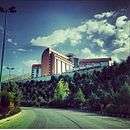Qazvin Islamic Azad University
| |
| Type | Private |
|---|---|
| Established | 1992 |
| President | Morteza Mousakhani |
| Students | 30,000 |
| Location |
Qazvin, Qazvin, IR |
| Campus | Barajin (Main) and Navab |
| Website |
www |
Qazvin Islamic Azad University (QIAU) (Persian: دانشگاه آزاد اسلامی قزوین) is a private research university based in Qazvin, Iran. It is one of the largest and most reputable branches of the Islamic Azad University. Sometimes, QIAU is referred by other phrases: Islamic Azad University of Qazvin or the Islamic Azad University, Qazvin Branch.
History
Qazvin Islamic Azad University was founded in 1992. The University now has about 30 thousand students in 81 programs and gives out degrees at the associate degree, Bachelor, Master discontinuous, Masters and PhD level.
Campus
Qazvin Islamic Azad University main campus is located on north of Tehran-Rasht highway in Barajin district. Most of campus land was developed, but there is still some undeveloped land. University main campus contains more than 15 buildings that five buildings of them are colleges:
- College of Biomedical Engineering,Electrical,IT & Computer Sciences
- College of Civil Engineering
- College of Architecture
- College of Industrial & Mechanical Engineering
- College of Accounting & Management
- College of Technical Diplomas (Navab college; not in main campus)
The main campus is one of the most beautiful university campus in country. There is One of the largest Iranian collegiate mosque in campus. In 2014 after buries of soldiers killed in 1980s Iran-Iraq war, Cultural authorities of university made decision to construct monument over their tomb. The monument completed in 2015, it is an architectural adaptation of Attar of Nishapur's famous poetry book "The Conference of the Birds" and shows seven valleys of love. Campus has unique recreation and entertainment facilities and simultaneously there are modern workshops, laboratory and technological units. Mechatronics Research Laboratory and Incubator Center of technology units are both in main campus. The central library of Qazvin Islamic Azad University with a collection in excess of 130000 books is a suitable place for research, glass faced of library make it able to use day light for study hall.
Academics
QIAU offers four academic degree programs : associate degree, B.A/B.Sc, MSc, and PhD.
Biomedical Engineering, Electrical, IT & Computer Sciences School
The faculty offered BSc in Computer Engineering (Software, Hardware), Electrical Engineering (Electronics, Control), and Information Technology, and Associate Diploma in discontinuous computing during the years 1993, 96, 97, 98 to 2003. Other fields of study in discontinuous BSc in Electrical Engineering (Electronics) were added to the faculty programme during 1999 to 2003. The education office of graduate studies commenced its activities in the faculty in 2003, with four fields of study in faculty of Electrical, Computer, and IT Engineering Moreover, the number of alumni in Computer Engineering (software) is 5 and number of received thesis is 60. Due to increasing number of students and the increasing demand for education space, this faculty has been transferred from its former place, the faculty of Associate Diploma in Navab, to its new building in Shahid Abbaspur Campus.
The Faculty present status: The present faculty space is 9682 square meters, including 37 classes, 6 classes equipped with audio-visual equipments, and 15 classes equipped with laboratory & workshop equipments for computer & electronic laboratories & workshops. Currently, 3882 students are enrolled in the faculty. Professor’s Numbers:
There are 33 academic staff in the faculty, as well as 42 guest lecturers. The above numbers are related to technical courses. Moreover, there are 8 academic staff and 6 guest lecturers in the departments of mechatronics, Computer Engineering (software, artificial intelligence), and IT engineering.More information
Mechatronics Research Laboratory (MRL)
Mechatronics Research Laboratory was established in 2003 as an independent research centre under supervision of Qazvin Islamic Azad University. One of its activities is participating RoboCup international competition.
External links
Coordinates: 36°19′16.20″N 50°2′9.44″E / 36.3211667°N 50.0359556°E
